|
#34 - Cambodia
Jeff Willner - 3 April 2002
(Siam Riep, CAMBODIA) . Lemon scented facial wipes,
cold drinks, a boxed lunch, and we were there. My Lonely Planet described
the overland trip from Bangkok to Siam Riep as "a one hour drive
to the Thailand border followed by a ten hour spine jolting marathon
over bad Cambodian dirt roads." It was an extra sixty bucks to fly
but I had gotten soft on the easy life in Bangkok. I'm not proud but
I took the wimpy way out. And man was it a good call. Two hours from
the comforts of Bangkok to the air conditioning in Siam Riep. Joined
with a fellow traveler off the same flight to split the cost of a taxi,
and was at the Angkor Wat temple for sunset the same day. Quick, easy,
painless. Money may not be everything, but it sure cuts down on butt
blisters.
The temples of Angkor were amazing, though walking around in the 40C heat
was less than stellar. Still, the two days were full of amazing perspectives
and great photos. If you can, go. And after talking with groups that came
in the long way... fly.
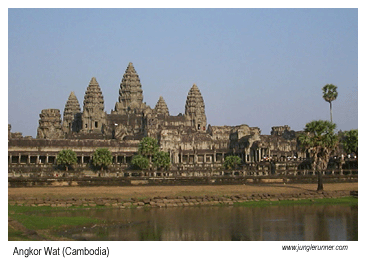 |
Angkor Wat, renowned Hindu temple complex
at Angkor, the capital of the Khmer Empire of Cambodia from the early
9th century to the mid-15th century, now a destination for Buddhist
pilgrims. Built for King Suryavarman II in the 12th century, Angkor
Wat is the most famous temple in Cambodia and is probably the largest
religious monument ever constructed. Taking more than 30 years to
build, the layout of the complex was conceived as an architectural
allegory of the Hindu cosmology (world concept). The entire complex
is surrounded by a moat over 5 km in length, representing the primordial
ocean, over which extends an elaborate 475-m causeway. |
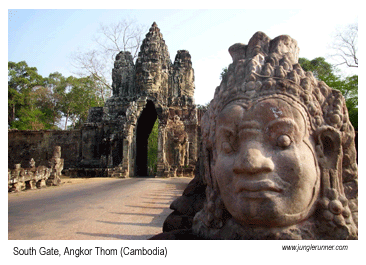 |
Angkor Thum, royal city and Buddhist
temple complex at Angkor, the capital of the Khmer Empire of Cambodia
from the early 9th century to the mid-15th century. Khmer king Jayavarman
VII, who reigned in the late 12th and early 13th centuries, began
building the vast monument at Angkor Thum (Khmer for .Angkor-the-Great.
or .Great City.) after he had regained control of the Angkor region
from the Cham army of northern Cambodia, which had seized it around
1177. Angkor Thum was built over and around buildings and temples
built by earlier Khmer kings, but its layout was modeled on Angkor
Wat, a Hindu temple complex south of Angkor Thum. |
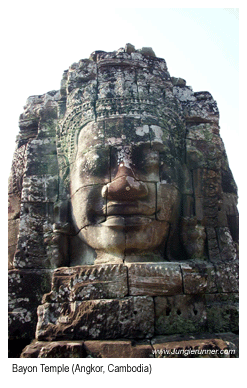 At
the center of Angkor Thum remains a stepped central temple.the Bayon.with
a 45 m (148 ft) high pyramidal tower at its center. The tower has
four massive heads carved into its top. Each head, representing both
the Buddha and King Jayavarman VII as the Buddha's reincarnation,
faces one of the four directions. Fifty-one smaller towers surrounded
the central tower, each likewise ornamented with four carved heads
facing the four directions. The two walls enclosing the Bayon were
decorated with bas-relief carvings. The exterior of the outer walls
included bas-reliefs depicting historical events, and the bas-reliefs
on the exterior of the inner walls depicted legendary scenes. In
Hindu symbolism, the central temple area represents Mount Meru.the
mountain on which the Hindu gods reside and which is regarded as
the center of the universe. After the death of Kin g Jayavarman VII,
the Bayon was converted into a Hindu temple by Brahman priests. At
the center of Angkor Thum remains a stepped central temple.the Bayon.with
a 45 m (148 ft) high pyramidal tower at its center. The tower has
four massive heads carved into its top. Each head, representing both
the Buddha and King Jayavarman VII as the Buddha's reincarnation,
faces one of the four directions. Fifty-one smaller towers surrounded
the central tower, each likewise ornamented with four carved heads
facing the four directions. The two walls enclosing the Bayon were
decorated with bas-relief carvings. The exterior of the outer walls
included bas-reliefs depicting historical events, and the bas-reliefs
on the exterior of the inner walls depicted legendary scenes. In
Hindu symbolism, the central temple area represents Mount Meru.the
mountain on which the Hindu gods reside and which is regarded as
the center of the universe. After the death of Kin g Jayavarman VII,
the Bayon was converted into a Hindu temple by Brahman priests.
|
 |
This temple was one of my favourites,
half fallen in, trees growing out of walls and ancient courtyards
of lichen covered carvings. It was like stepping into a forgotten
exotic corner of history.
|
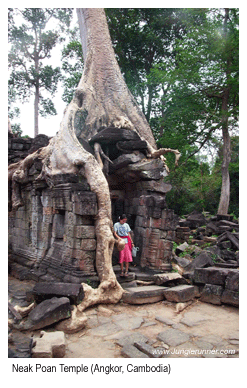 Khmer
Kingdoms, succession of Southeast Asian monarchies based in present-day
Cambodia from the 6th to 16th centuries. Modern Cambodia is the political
remnant of the Khmer state that reached its peak during the Angkor
period from the 9th to 15th centuries. During this period, the Khmer
empire extended beyond Cambodia to incorporate large areas of Laos,
eastern Thailand, and southern Vietnam. The Khmer kingdoms were derived
from the culturally Indian state of Funan and the Kingdom of Zhenla.
The great Khmer empire of the Angkor period was founded by Jayavarman
II (reigned 802-850), who took back portions of Zhenla from the Sri
Vijaya empire of Sumatra and was consecrated as a god-king. The capital
of the kingdom he created was moved first to the Ttnli Sap, then
under Yasovarman I (reigned 889-900), to Angkor, where great stone
temples to the gods of Hinduism, and reservoirs and canals for irrigation,
were built. Khmer culture flourished under royal patronage. After
decades of peace, King Suryavarman I (reigned 1004?-1050?) pushed
into Thailand and doubled the number of cities under his control.
Succession feuds led to a new royal dynasty founded by Suryavarman
II (reigned 1113-1150), founder of Angkor Wat, who attacked Thailand,
Vietnam, and the eastern Kingdom of Champa. Khmer
Kingdoms, succession of Southeast Asian monarchies based in present-day
Cambodia from the 6th to 16th centuries. Modern Cambodia is the political
remnant of the Khmer state that reached its peak during the Angkor
period from the 9th to 15th centuries. During this period, the Khmer
empire extended beyond Cambodia to incorporate large areas of Laos,
eastern Thailand, and southern Vietnam. The Khmer kingdoms were derived
from the culturally Indian state of Funan and the Kingdom of Zhenla.
The great Khmer empire of the Angkor period was founded by Jayavarman
II (reigned 802-850), who took back portions of Zhenla from the Sri
Vijaya empire of Sumatra and was consecrated as a god-king. The capital
of the kingdom he created was moved first to the Ttnli Sap, then
under Yasovarman I (reigned 889-900), to Angkor, where great stone
temples to the gods of Hinduism, and reservoirs and canals for irrigation,
were built. Khmer culture flourished under royal patronage. After
decades of peace, King Suryavarman I (reigned 1004?-1050?) pushed
into Thailand and doubled the number of cities under his control.
Succession feuds led to a new royal dynasty founded by Suryavarman
II (reigned 1113-1150), founder of Angkor Wat, who attacked Thailand,
Vietnam, and the eastern Kingdom of Champa.
|
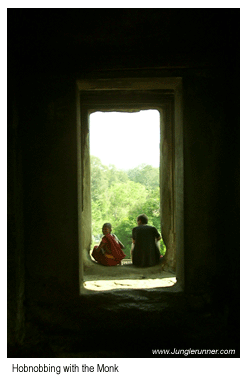 The chaos that followed the taking of the Khmer throne and invasion
by Champa ended with the liberation of Angkor by a prince, later
crowned as Jayavarman VII (reigned 1181-1219), who reconsolidated
the state and conquered Champa. He favored Mahayana Buddhism and
built the Bayon, the great Buddhist temple at Angkor with its enormous
faces. After his death, the Khmer kingdom began to shrink under pressure
from the Thai Kingdom of Sukhothai, but retained power and splendor
throughout the 13th century. The chaos that followed the taking of the Khmer throne and invasion
by Champa ended with the liberation of Angkor by a prince, later
crowned as Jayavarman VII (reigned 1181-1219), who reconsolidated
the state and conquered Champa. He favored Mahayana Buddhism and
built the Bayon, the great Buddhist temple at Angkor with its enormous
faces. After his death, the Khmer kingdom began to shrink under pressure
from the Thai Kingdom of Sukhothai, but retained power and splendor
throughout the 13th century.
Angkor was abandoned as the Cambodian capital in 1431, but
Angkor Wat was turned into a Buddhist temple and remained in
use. French archaeologists began uncovering the jungle-laden
Angkor site in 1863, and for nearly a century thereafter the
French conducted an extensive project of reconstruction and research.
During the political and military upheavals of the 1970s and
1980s, however, the restoration effort was put on hold and the
Angkor site was damaged, pillaged, and neglected. In 1987 the
Archaelogical Survey of India began a seven-year restoration
project on the Angkor Wat complex. Since 1991 the United Nations
Educational, Scientific, and Cultural Organization (UNESCO) has
helped the Cambodian government coordinate an international effort
to research and preserve the sites in Angkor National Park.
Microsoft. Encarta. Reference Library 2002.
|
|

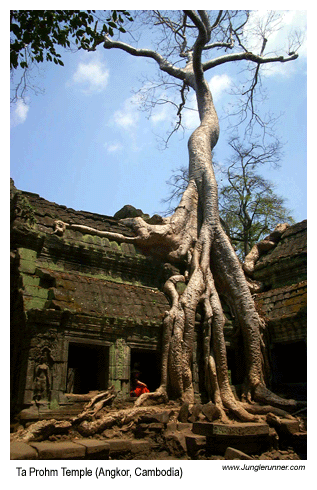


 At
the center of Angkor Thum remains a stepped central temple.the Bayon.with
a 45 m (148 ft) high pyramidal tower at its center. The tower has
four massive heads carved into its top. Each head, representing both
the Buddha and King Jayavarman VII as the Buddha's reincarnation,
faces one of the four directions. Fifty-one smaller towers surrounded
the central tower, each likewise ornamented with four carved heads
facing the four directions. The two walls enclosing the Bayon were
decorated with bas-relief carvings. The exterior of the outer walls
included bas-reliefs depicting historical events, and the bas-reliefs
on the exterior of the inner walls depicted legendary scenes. In
Hindu symbolism, the central temple area represents Mount Meru.the
mountain on which the Hindu gods reside and which is regarded as
the center of the universe. After the death of Kin g Jayavarman VII,
the Bayon was converted into a Hindu temple by Brahman priests.
At
the center of Angkor Thum remains a stepped central temple.the Bayon.with
a 45 m (148 ft) high pyramidal tower at its center. The tower has
four massive heads carved into its top. Each head, representing both
the Buddha and King Jayavarman VII as the Buddha's reincarnation,
faces one of the four directions. Fifty-one smaller towers surrounded
the central tower, each likewise ornamented with four carved heads
facing the four directions. The two walls enclosing the Bayon were
decorated with bas-relief carvings. The exterior of the outer walls
included bas-reliefs depicting historical events, and the bas-reliefs
on the exterior of the inner walls depicted legendary scenes. In
Hindu symbolism, the central temple area represents Mount Meru.the
mountain on which the Hindu gods reside and which is regarded as
the center of the universe. After the death of Kin g Jayavarman VII,
the Bayon was converted into a Hindu temple by Brahman priests.
 Khmer
Kingdoms, succession of Southeast Asian monarchies based in present-day
Cambodia from the 6th to 16th centuries. Modern Cambodia is the political
remnant of the Khmer state that reached its peak during the Angkor
period from the 9th to 15th centuries. During this period, the Khmer
empire extended beyond Cambodia to incorporate large areas of Laos,
eastern Thailand, and southern Vietnam. The Khmer kingdoms were derived
from the culturally Indian state of Funan and the Kingdom of Zhenla.
The great Khmer empire of the Angkor period was founded by Jayavarman
II (reigned 802-850), who took back portions of Zhenla from the Sri
Vijaya empire of Sumatra and was consecrated as a god-king. The capital
of the kingdom he created was moved first to the Ttnli Sap, then
under Yasovarman I (reigned 889-900), to Angkor, where great stone
temples to the gods of Hinduism, and reservoirs and canals for irrigation,
were built. Khmer culture flourished under royal patronage. After
decades of peace, King Suryavarman I (reigned 1004?-1050?) pushed
into Thailand and doubled the number of cities under his control.
Succession feuds led to a new royal dynasty founded by Suryavarman
II (reigned 1113-1150), founder of Angkor Wat, who attacked Thailand,
Vietnam, and the eastern Kingdom of Champa.
Khmer
Kingdoms, succession of Southeast Asian monarchies based in present-day
Cambodia from the 6th to 16th centuries. Modern Cambodia is the political
remnant of the Khmer state that reached its peak during the Angkor
period from the 9th to 15th centuries. During this period, the Khmer
empire extended beyond Cambodia to incorporate large areas of Laos,
eastern Thailand, and southern Vietnam. The Khmer kingdoms were derived
from the culturally Indian state of Funan and the Kingdom of Zhenla.
The great Khmer empire of the Angkor period was founded by Jayavarman
II (reigned 802-850), who took back portions of Zhenla from the Sri
Vijaya empire of Sumatra and was consecrated as a god-king. The capital
of the kingdom he created was moved first to the Ttnli Sap, then
under Yasovarman I (reigned 889-900), to Angkor, where great stone
temples to the gods of Hinduism, and reservoirs and canals for irrigation,
were built. Khmer culture flourished under royal patronage. After
decades of peace, King Suryavarman I (reigned 1004?-1050?) pushed
into Thailand and doubled the number of cities under his control.
Succession feuds led to a new royal dynasty founded by Suryavarman
II (reigned 1113-1150), founder of Angkor Wat, who attacked Thailand,
Vietnam, and the eastern Kingdom of Champa. The chaos that followed the taking of the Khmer throne and invasion
by Champa ended with the liberation of Angkor by a prince, later
crowned as Jayavarman VII (reigned 1181-1219), who reconsolidated
the state and conquered Champa. He favored Mahayana Buddhism and
built the Bayon, the great Buddhist temple at Angkor with its enormous
faces. After his death, the Khmer kingdom began to shrink under pressure
from the Thai Kingdom of Sukhothai, but retained power and splendor
throughout the 13th century.
The chaos that followed the taking of the Khmer throne and invasion
by Champa ended with the liberation of Angkor by a prince, later
crowned as Jayavarman VII (reigned 1181-1219), who reconsolidated
the state and conquered Champa. He favored Mahayana Buddhism and
built the Bayon, the great Buddhist temple at Angkor with its enormous
faces. After his death, the Khmer kingdom began to shrink under pressure
from the Thai Kingdom of Sukhothai, but retained power and splendor
throughout the 13th century.